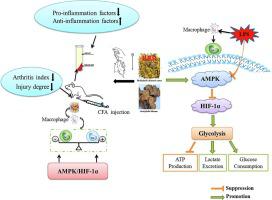International Immunopharmacology ( IF 4.8 ) Pub Date : 2020-07-29 , DOI: 10.1016/j.intimp.2020.106830 Yun Yu 1 , Weiwei Cai 1 , Jing Zhou 1 , Huaqiu Lu 1 , Ying Wang 1 , Yining Song 1 , Rui He 1 , Feilong Pei 1 , Xiaodie Wang 1 , Renhao Zhang 1 , Hao Liu 2 , Fang Wei 3

|
Berberine (BBR) is the effective constituent of Cortex phellodendri and was characterized as an excellent anti-microbial agent with significant anti-inflammatory effects. Previously, we had demonstrated that BBR alleviated the inflammatory response in adjuvant-induced arthritis (AA) rats by regulating polarization of macrophages. However, the exact mechanics by which BBR regulates macrophage polarization remained unclear. Here, we showed that BBR treatment had little influence on total number of macrophages in joints of AA rats, but increased the proportion of M2 macrophages and decreased the proportion of M1 macrophages. Meanwhile, we found BBR up-regulated the expression of AMP-activated protein kinase phosphorylation (p-AMPK) and down-regulated the expression of Hypoxia inducible factor 1α (HIF-1α) in synovial macrophages of AA rats. In vitro, using LPS-stimulated peritoneal macrophages from normal rats, we also verified that pretreatment with BBR promoted transition from M1 to M2 by up-regulating the expression of p-AMPK and suppressing the expression of HIF-1α. Compound C (an AMPK inhibitor) could abrogate the inhibition of BBR on migration of macrophages. Glycolysis of M1 suppressed by BBR through decreasing lactate export, glucose consumption, and increasing intracellular ATP content, which was remarkably reversed by Compound C. These findings indicated that anti-arthritis effect of BBR is associated with regulating energy metabolism of macrophages through AMPK/HIF-1α pathway.
中文翻译:

黄连素的抗关节炎作用与通过 AMPK/HIF-1α 通路调节巨噬细胞能量代谢有关。
黄连素 (BBR) 是黄柏的有效成分并且被描述为具有显着抗炎作用的优良抗微生物剂。以前,我们已经证明 BBR 通过调节巨噬细胞的极化减轻了佐剂诱导的关节炎 (AA) 大鼠的炎症反应。然而,BBR 调节巨噬细胞极化的确切机制仍不清楚。在这里,我们发现 BBR 处理对 AA 大鼠关节中巨噬细胞的总数几乎没有影响,但增加了 M2 巨噬细胞的比例并降低了 M1 巨噬细胞的比例。同时,我们发现BBR上调了AA大鼠滑膜巨噬细胞中AMP活化蛋白激酶磷酸化(p-AMPK)的表达并下调了缺氧诱导因子1α(HIF-1α)的表达。体外使用来自正常大鼠的 LPS 刺激的腹腔巨噬细胞,我们还验证了 BBR 预处理通过上调 p-AMPK 的表达和抑制 HIF-1α 的表达促进了从 M1 到 M2 的转变。化合物 C(AMPK 抑制剂)可以消除 BBR 对巨噬细胞迁移的抑制作用。BBR 通过减少乳酸输出、葡萄糖消耗和增加细胞内 ATP 含量来抑制 M1 的糖酵解,这被化合物 C 显着逆转。 这些发现表明 BBR 的抗关节炎作用与通过 AMPK/HIF 调节巨噬细胞的能量代谢有关-1α途径。











































 京公网安备 11010802027423号
京公网安备 11010802027423号